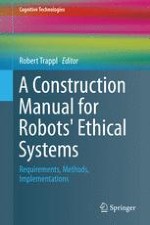2015 | OriginalPaper | Buchkapitel
8. Constrained Incrementalist Moral Decision Making for a Biologically Inspired Cognitive Architecture
verfasst von : Tamas Madl, Stan Franklin
Erschienen in: A Construction Manual for Robots' Ethical Systems
Aktivieren Sie unsere intelligente Suche, um passende Fachinhalte oder Patente zu finden.
Wählen Sie Textabschnitte aus um mit Künstlicher Intelligenz passenden Patente zu finden. powered by
Markieren Sie Textabschnitte, um KI-gestützt weitere passende Inhalte zu finden. powered by
